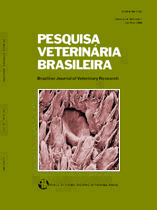 |
|
|
|
Year 2011 - Volume 31, Number 1001
|

|
Morphological characterization and frenquency of stages of the seminiferous epithelium cycle in captive bred Spix’s Yellow-Toothed (Galea spixii Wagler, 1831, 31(Supl.1): 18-24
|
ABSTRACT.- Santos P.R.S., Carrara T.V.B., Silva L.C.S., Silva A.R., Oliveira M.F. & Assis Neto A.C. 2011. [Morphological characterization and frenquency of stages of the seminiferous epithelium cycle in captive bred Spix’s Yellow-Toothed (Galea spixii Wagler, 1831).] Caracterização morfológica e frequência dos estádios do ciclo do epitélio seminifero em preás (Galea spixii, Wagler 1831) criados em cativeiro. Pesquisa Veterinária Brasileira 31(Supl.1):18-24. Departamento de Cirurgia, Faculdade de Medicina Veterinária e Zootecnia, Universidade de São Paulo, Av. Prof. Dr. Orlando Marques de Paiva 87, São Paulo, SP 05508-270, Brazil. E-mail: pauloramos@usp.br
Studies based on the testicular characteristics are strongly associated with the reproductive efficiency of various species. Thus, the developed project aimed to identify the cells of the seminiferous epithelium, histologically characterized their associations, which form stages, and determine the frequency of these. The fragments of testes, 30, 45, 60, 75, 90, 105, 120, 150 days were collected Multiplication Center of Universidade Federal Rural do Semi-Árido, Mossoró, RN. Through the process of fixing, washing in solutions of increasing concentrations of alcohols (70-100%), dehydration in xylene, inclusion in Histosec ®, preparation of histological slides, stained with hematoxylin and eosin (HE) and their photomicrographs for the characterization of cell nuclei of the germinal epithelium and the definition of the eight stages of the seminiferous epithelium cycle (CES) based on the tubular morphology method. The different age groups all animals at 90 to 150 days of age showed all stages of the CES. Stages I and III showed the highest and lowest frequency, respectively. Animals categorized as prepubertal (30 days), pubertal (45 to 90 days old) and postpubertal (105 to 150 days of age) had stage I, IV and VIII with a higher frequency, respectively. |
| |
|
|
| |
|
 |